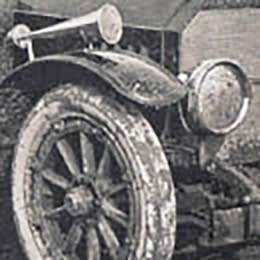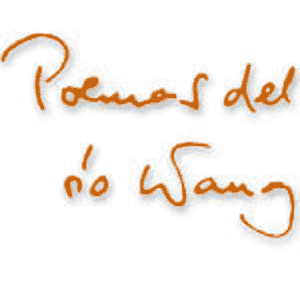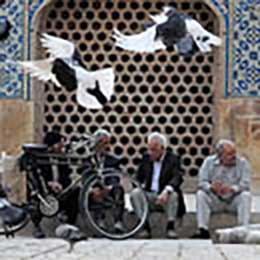
It’s almost a hundred years now that these people have been staring fixedly at the lens of the long-destroyed camera. And what a hundred years! The postcard sent to St. Petersburg has survived several wars and civil wars, a blockade, evacuations, fall of leaders and regimes, its address became invalid and then valid again. And still there are a few years left from the hundred.
For the standing people the center of the scene at this moment is the photographer and his camera. But for the photographer – and also for them some minutes earlier and later – the center is the group of two or three men turning away from us and so busily focusing on something on the ground as if it did not interest them that they are just missing the only opportunity in their lives to figure on a picture.

We only know from the inscription printed on the back of the postcard what they are doing: Праздничное развлеченiе рабочихъ “Игра въ орлянку” – A festive entertainment for the workers: “Heads or Tails”
The rare term орлянка comes from орел, “eagle” and refers to small things related to or representing an eagle. Such as the old czarist officer’s belt buckle which was also called like this.

The big Brockhaus-Efron’s Энциклопедический словарь (1896-1907) gives this definition:
Орлянка: простонародная игра, состоящая в том, что бросают монету, и тот, кто угадает, какой стороной (решеткой или орлом) упадет она, выигрывает ее.
Orlyanka: game of the common people, consisting in throwing up a money. The player who figures out which side of the coin will be up, the lattice or the eagle, wins the money.
Orlyanka: game of the common people, consisting in throwing up a money. The player who figures out which side of the coin will be up, the lattice or the eagle, wins the money.
This definition makes it clear that the common people – I like very much the synthetic term простонародный, circa “simplefolkish” – pursued this festive entertainment with the lowest value kopeiki of which the two sides, at least at the time when the term was coined, was in fact decorated with the monogram of the ruler – for the illiterate: a lattice – and the double-headed imperial eagle.




For a Hungarian it is so obvious to call this game fej vagy írás, “head or script” that he would not believe if somebody told him that no other people says it exactly like this. The Germans say Kopf oder Zahl, the Spaniards and Italians Cara o cruz and Testa o croce, the Poles – just like Russians, and obviously after the same kopeiki – Orzeł czy reszka, the Irishmen Head or harps, the Greeks Κορώνα η γράμματα (crown or script), and the ancient Latins Navia aut caput (ship or head [of Janus]), depending on the actual designs of their coins. The most absurd one is the English Heads or tails, where “tails” does not refer to the image on the reverse, but as we read it in the 1870 edition of Brewer’s Dictionary of Phrase and Fable, “is the opposite and obvious reverse to heads. The expression ‘can’t make head nor tail of it’ expresses this concept of opposites”.
If the Russian simplefolk were wealthy enough, then instead of kopeiki they could have played the game also with poltiniks (half-rubles), and thus call it “head or eagle” or even “one head or double-head”. But then they certainly would have had some different festive entertainment.

“If on a Sunday you looked down from the hill, you could only see the restless groups of those playing “heads or tails” everywhere. Now they bend down to throw money in the center of the circle or to clean up the winnings, now the toss their heads to stare at the sky, with their eyes following the path of the way of the petak [five kopeks], and then running violently to where it fell on the ground. If the head is up, then only the thrower bends down to pick up all the money, while the others dig out new stake from their pockets and erect new columns of copper and silver coins, with the silver ones on the top so it could be clearly seen how much money it is. The thrower examines the towers, and if the value exceeds the power of his purse, he lets removed from it, but if his pocket can bear it, he says: “I hold it!” He spits on the head – this is a kind of superstition – and rubs it to the sole of his boot, then he throws with an expert hand the petak, which is spinning whistling in the air, it is almost lost from sight, and the crowd once again raise their heads upwards. – “They are praying for rain” – the kibitzes say.”
V. A. Gilyarovsky: Мои скитания (My Travels), “The Theatre”
According to the inscription on the back of the postcard, the picture was taken on the territory of the Ленскiй Горный Округъ, the Lensk Mining District. The town of Lensk was founded along the Siberian river of Lena on the place of an Evenki settlement called Mukhtua which means “large water”. In the 19th and 20th century it was one of the centers of political prisoners sent to Siberian exile, and a number of various mines operated in its neighborhood. Such was also the Феодосьевский прiискъ, Feodosev Mine to be seen on the photo. In local histories one could certainly find more data about it, but on the internet it has only a single occurrence. It is frozen, like an archive photo, into the sample sentence taken from Soviet writer Vissarion Sayanov with which the Russian academic dictionary and its offsprings have illustrated the verb смочь, “can” since 1957:
“Вскоре Чердынцев смог вернуться на Феодосьевский прииск.”
“Cherdintsev could soon return to the Feodosev Mine.”
Perhaps he is already there on the picture.
From late 19th century a number of Russian companies of photography found it profitable to publish postcards on Siberian towns and landscapes. There were surely several photos taken on the territory of the Lensk Mining District as well, if this one is numbered as 58. Eight further ones can be seen on the portal devoted to the vintage postcards of the Russian Empire.

The sender of the postcard informs Anna Alexandrovna that if all goes well, he will arrive between 20 and 22 August to St. Petersburg. The date of the postcard is 28 July 1914.
The next day at five o’clock in the morning the general mobilization was ordered in Russia.

























































































Add comment